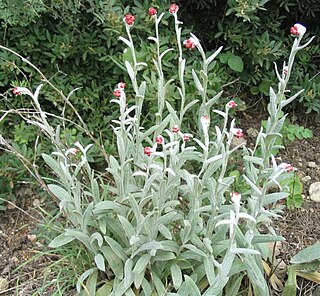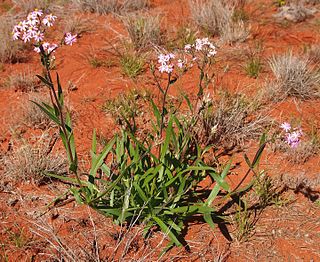
The genus Helichrysum consists of an estimated 600 species of flowering plants in the sunflower family (Asteraceae). The type species is Helichrysum orientale. They often go by the names everlasting, immortelle, and strawflower. The name is derived from the Ancient Greek words ἥλιος and χρῡσός.

The Gnaphalieae are a tribe of flowering plants in the family Asteraceae. It is most closely related to the tribes Anthemideae, Astereae, and Calenduleae.

Waitzia is a genus of Australian plants in the tribe Gnaphalieae within the family Asteraceae. The genus is native to Australia, where it grows in Western Australia, the Northern Territory, New South Wales, Victoria and South Australia.
- Waitzia acuminataSteetz - orange immortelle
- Waitzia corymbosaJ.C.Wendl.
- Waitzia nitida(Lindl.) Paul G.Wilson - golden waitzia
- Waitzia podolepis(Gaudich.) Benth.
- Waitzia suaveolens(Benth.) Druce - fragrant waitzia

Rhodanthe, also known as sunray or pink paper daisy, is a genus of Australian plants in the tribe Gnaphalieae within the family Asteraceae.

Leucochrysum is a genus of flowering plants in the tribe Gnaphalieae within the family Asteraceae, endemic to Australia.

Erymophyllum is a genus of flowering plants in the family Asteraceae, endemic to Australia.

Hyalosperma is a genus of Australian flowering plants in the family Asteraceae.

Leiocarpa is a genus of plants in the family Asteraceae, native to Australia.
Leptorhynchos is a genus of annual or perennial herbs in the family Asteraceae. All species are endemic to Australia. These include:

Chrysocephalum semipapposum, commonly known as clustered everlasting is a perennial shrub native to Australia. Clustered everlasting belongs to the family Asteraceae. C. semipapposum produces terminal flowers heads in clusters, mainly between spring and early summer with silver-grey appearing stems and branches. It grows up to 40cm high and 60 cm high, although there have been some varieties which can grow up to 1 m. C. semipapposum is often confused with Chrysocephalum apiculatum or 'yellow buttons', due to their similar appearances. C. semipapposum has 4 different subspecies, however they lack distinctive qualities and are often hard to identify. C. semipapposum is endemic to Australia and can be found in multiple states, most notably within Victoria. The plant is found in a variety of habitats including dry rocky regions. Clustered everlasting often grows sparsely and is rarely found in abundance and can be mistaken for a weed. Clustered everlasting has many uses, including as a source of nectar for butterflies, cut flowers or as an addition to a garden.

Coronidium is a genus of flowering plants in the family Asteraceae. The genus is endemic to Australia.

Argentipallium is a genus of flowering plants in the family Asteraceae. The genus, which is endemic to Australia, was first formally described in 1992 by Paul G. Wilson in the botanical journal Nutsyia.

Schoenia is a genus of Australian plants in the tribe Gnaphalieae within the family Asteraceae.

Coronidium scorpioides, commonly known as the button everlasting, is a perennial herbaceous shrub in the family Asteraceae found in Australia. Previously known as Helichrysum scorpioides, it was placed in the newly described genus Coronidium in 2008.

Rhodanthe anthemoides, commonly known as chamomile sunray, is a flowering plant in the family Asteraceae. It is a small, perennial shrub with greyish-green leaves, white papery flowers, yellow centre and is endemic to Australia.

Leucochrysum albicans, commonly known as hoary sunray, is a flowering plant in the family Asteraceae. It is a small perennial with grey leaves, white or yellow flower-heads and is endemic to Australia.
Paul Graham Wilson is an Australian botanist. As of 1998, Wilson was the most prolific contributor to the journal Nuytsia, contributing to the first issue in 1970 and to the 12th volume in 1998, which was dedicated to him for his contributions to plant taxonomy and to celebrate his 70th birthday. Since his retirement from the Western Australian Herbarium in 1993, he has helped to maintain a comprehensive census of the flora of Western Australia.

Argentipallium niveum is a species of flowering plant within the genus, Argentipallium, in the daisy family (Asteraceae). It is endemic to Western Australia.

Rhodanthe battii is a species of flowering plant in the family Asteraceae, native to Western Australia.

Coronidium rupicola, commonly known as the yellow button, is a flowering plant in the family Asteraceae. It is a small, upright, perennial shrub with yellow flowers borne on a single stem and is endemic to Queensland, Australia.

















